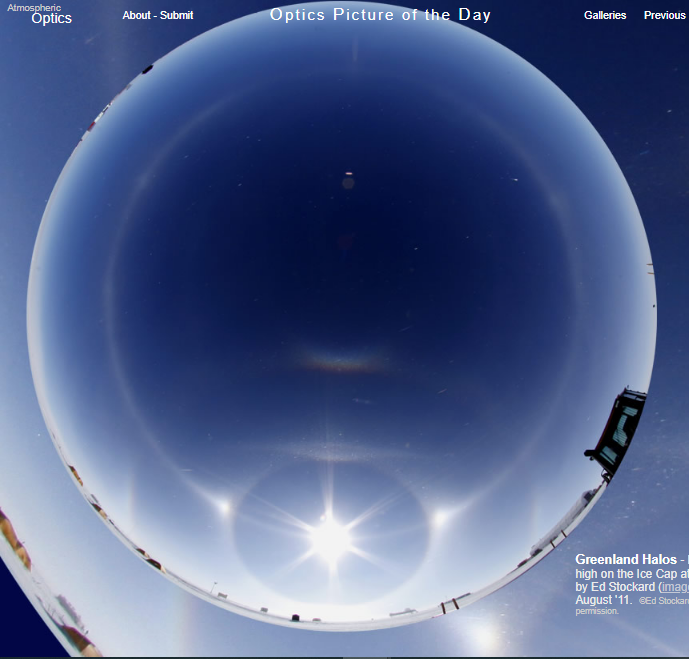OPOD - Greenland Halos
OPOD - Greenland Halos: A Fascinating Display of Atmospheric Optics
Greenland Halos, a captivating phenomenon of atmospheric optics, never fail to mesmerize observers with their ethereal beauty. These stunning displays occur high on the Ice Cap at Summit Station, as photographed by Ed Stockard on August 25th, 2011. Crystal habit and orientation play crucial roles in the formation of these halos, while location seems to be inconsequential, as they can be found anywhere in the world, and possibly beyond. However, the presence of diamond dust, which appears as individual glinting crystals, bestows an advantage to polar regions.
The diversity of Greenland Halos arises from the varying crystal habits and orientations that contribute to their formation. Random or pseudo-randomly oriented crystals or clusters produce the well-known 22 and 46-degree radius circles around the sun. On the other hand, singly oriented columns give rise to the common upper tangent arc, the less frequent infralateral and supralateral arcs, as well as the rare Wegener and subhelic arcs.
Plate-oriented crystals contribute to the appearance of sundogs, which are bright spots on either side of the sun. Additionally, they play a role in the formation of the 120-degree parhelia, which are bright spots located at a distance from the sun. The circumzenithal arc, a beautiful and colorful halo encircling the zenith, is also a product of plate-oriented crystals.
Interestingly, the parhelic circle, which forms a complete circle around the sky, originates from all orientations except the randomly tilted ones. This unique feature adds to the allure of Greenland Halos, making them a truly captivating spectacle.
The occurrence of Greenland Halos is not limited to polar regions. While diamond dust provides an advantage for their formation in these regions, halos can manifest in any part of the world given the right conditions. The presence of specific crystal habits and orientations is the key to witnessing these atmospheric wonders.
The study of Greenland Halos and other atmospheric optics phenomena has greatly benefited from advancements in technology. With the advent of high-quality cameras, photographers and researchers can capture these fleeting moments with exceptional detail, allowing for further analysis and understanding of these mesmerizing displays.
The understanding of Greenland Halos and other atmospheric optics phenomena is a continuous journey. Researchers and enthusiasts alike are constantly striving to unravel the mysteries behind their formation and discover new insights into the complex interplay of crystal habits, orientations, and atmospheric conditions.
In conclusion, Greenland Halos are a remarkable manifestation of atmospheric optics, captivating observers with their enchanting beauty. The interplay between crystal habit and orientation gives rise to a diverse range of halos, each with its unique characteristics. While location may not be a determining factor, the presence of diamond dust in polar regions enhances the likelihood of witnessing these extraordinary displays. As our understanding of atmospheric optics advances, we continue to unlock the secrets behind these natural wonders, bringing us closer to comprehending the intricacies of our awe-inspiring atmosphere.

Greenland Halos - Photographed high on the Ice Cap at Summit Station by Ed Stockard (images) on 25th August '11. ©Ed Stockard, shown with permission.

Good halos require crystal habit - habit - habit and orientation - orientation - orientation. Location does not matter, they can be found anywhere in the world and possibly elsewhere although it must be admitted that diamond dust, seen here as individual crystals glinting their rays, confers an advantage to polar regions.
Random or pseudo randomly oriented crystals or clusters produced the 22 and 46 degree radius circles around the sun.
'Singly oriented columns gave the common upper tangent arc, the less common infralateral and supralateral arcs and the rare Wegener and subhelic arcs.
Plate oriented crystals contributed the sundogs, the 120 degree parhelia and the circumzenithal arc.
The parhelic circle girding the sky came from all orientations except the randomly tilted ones.
Note: this article has been automatically converted from the old site and may not appear as intended. You can find the original article here.
Reference Atmospheric Optics
If you use any of the definitions, information, or data presented on Atmospheric Optics, please copy the link or reference below to properly credit us as the reference source. Thank you!
-
<a href="https://atoptics.co.uk/blog/opod-greenland-halos/">OPOD - Greenland Halos</a>
-
"OPOD - Greenland Halos". Atmospheric Optics. Accessed on November 22, 2024. https://atoptics.co.uk/blog/opod-greenland-halos/.
-
"OPOD - Greenland Halos". Atmospheric Optics, https://atoptics.co.uk/blog/opod-greenland-halos/. Accessed 22 November, 2024
-
OPOD - Greenland Halos. Atmospheric Optics. Retrieved from https://atoptics.co.uk/blog/opod-greenland-halos/.